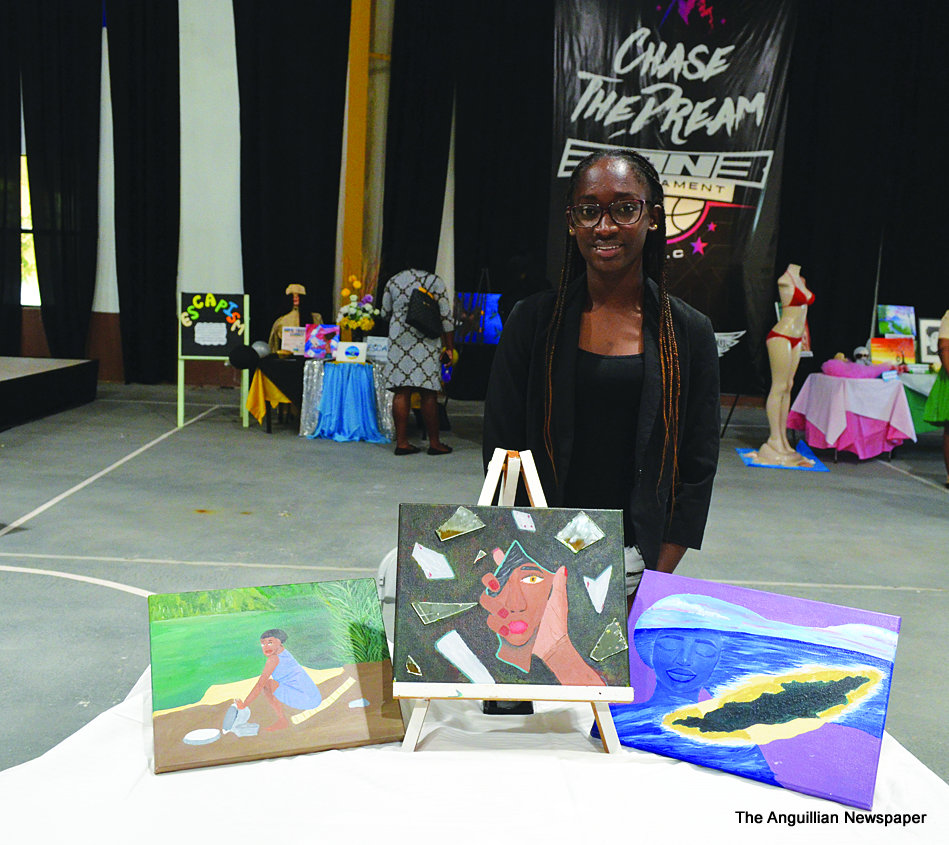On Wednesday, 20th April, The Anguillian newspaper was invited to the Rodney MacArthur Rey Auditorium to view the artwork of outstanding Fifth Form visual arts students. The art pieces, depicting various themes, were on display.
Some of the bulding artists spoke with The Anguillian, and they gave brief descriptions of their work.
The first artist, Ms. Jafrazie Webster, created artwork with the theme “Seven Deadly Sins”. She described her work as displays depicting the transgressions that tarnish the soul. These included: the pride of a woman who is obsessed with herself; a glutton who indulges in eating excessively; a lazy woman who lays in a hammock for most of the day and leaves her domestic chores undone; a pair of lady’s legs and thighs that appears sexy and sensual; bleeding hands depicting acts of murder; and a greedy, materialistic manikin who shows off herself and all the ‘bling’ that she owns.
The second artist was Mr. Ashton Shivnarine, created art under the theme “Agro Business” depicting the hard work that goes into the production of fruits and vegetables. He said his theme was broken down into two parts, namely, traditional plantation crops and livestock.
Ashton portrayed these in textile manipulations and paintings. He crafted an ear of corn carved out of wood. In addition, he displayed a mango painting, batik works depicting sugar cane, and a painting of a pod of cocoa. All of these were surrouned by real fruits and vegetables. He said that he was very proud of his work.
Next, we visited Mr. Matthew Khan. The theme of his work was “Flora and Fauna”, and he depicted plant and animal art in painting and textiles. Among these was the display of a turtle dove which he noted as Anguilla’s national bird, crafted from batik. He also demonstrated the painting of a red, unique type of flower called Heliconia bihai which is native to North and South America – as well as some regions of the Caribbean. In addition, he created beautiful paintings of bell flowers.
Matthew also exhibited a tie-die bull’s eye piece of art. He said he used the stenciling method to create sea creatures on fabric. The bull’s eye in the centre is in the form of a mahi-mahi, while on the four edges there are images of manta rays and at the four corners are prints of dolphins. He, like Ashton, said that he is excited about his art.
Next, we visited Thalia Hinds’ displays. Her work’s theme was “Emotions”. Her expressive forms were painting and mix media, in which she exhibited three pieces. Her first painting showed sadness due to poverty – where a woman washes her dishes at the riverside because she cannot afford the facilities to wash them at home. Her second piece depicted a young girl who is depressed, and because she is uncomfortable, she cuts herself over and over again. Her last piece showed a lady relaxing peacefully in a hammock under a coconut tree – while she enjoys delightful Anguilla sea breezes.
The next table we visited was that of Ms. Carlisia Adams. Carlisia’s theme was “Amerindian Women” – displaying the indigenous people of the Caribbean. She displayed five pieces. Her first piece was that of the ‘Princess of Light’ who glows in light because she will soon be a queen. She bears a red stripe across her forehead which represents her strength. This painting depicts the custom of body paintings back then.
Her second piece showed a colourful portion of a woman’s body which is called ‘Body of Symbols’. These symbols represent the official position of tribal Amerindian women, and depict what roles they were responsible for within their communities. Her third piece depicted a ‘Female Amerindian Soldier’ who bears her weapon in preparation for war. According to Carlisia, “this woman is quite strong on the inside, even though she may be fragile on the outside. She fears that she might be defeated, but nevertheless, she stands her ground.”
Then, her fourth piece of art depicted the ‘Future Taino’ who is destined to walk in the footsteps of her ancestors. Her fifth and final piece represented a ‘Female Saviour’ – a spirit who brought relief to the Amerindians whenever they were in distress. Carlisia expressed her delight in working with this educational theme.
The next art display was that of Mia Pradel. Her theme was “Mental Health”. She said she chose this theme because good mental health was very important to help one make it through life in these crucial times. Her first piece of art depicted anxiety. It is a picture of a young girl in the darkness who experiences much stress in her life.
Mia’s next piece depicted one who is contemplating suicide. She said the colour yellow is predominant in this painting, since it is the main colour for suicide awareness. Green signifies the overall mental health, and blue represents the awareness of autism. Her other piece, on a light grey background, depicted depression. Hands in this drawing represent a trap that the mind is confined to. In this piece, there is also a heart encircled by a tight string that represents feelings of stress, heartbreak and sadness.
Her final piece was a pillow. Mia described the pillow – one side of the pillow is dark grey, representing dismal days, while the other side displays the beautiful colours of pink and purple, which signify bright and cheerful days.
There were a few other display tables which we visited, but due to constraints of space we were unable to include all of them at this time. Those whose descriptive works were not included here are: Shonte Hope, with the theme “Escapism”; Brielle Letang, whose theme was “Caribbean Women Fighting in the Struggle”; and Chyriki Richardson-Yearwood, who worked under the theme “Tranquil Ties”.



















